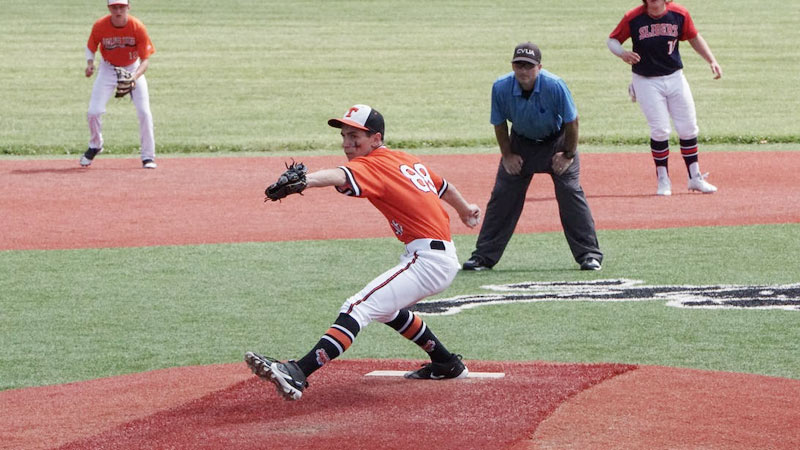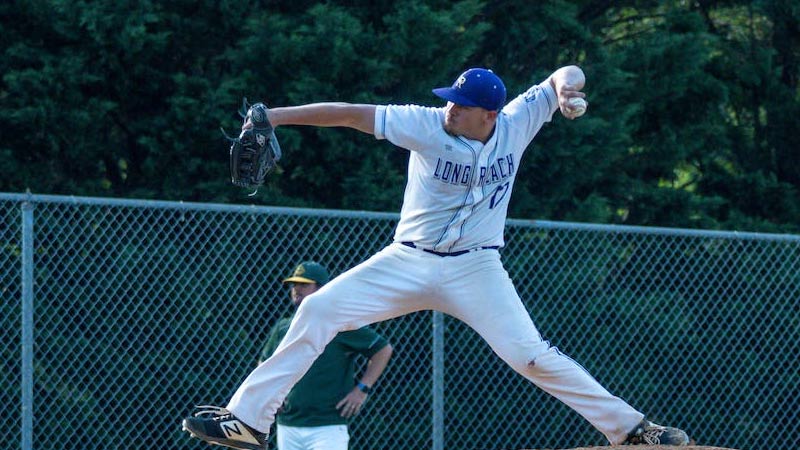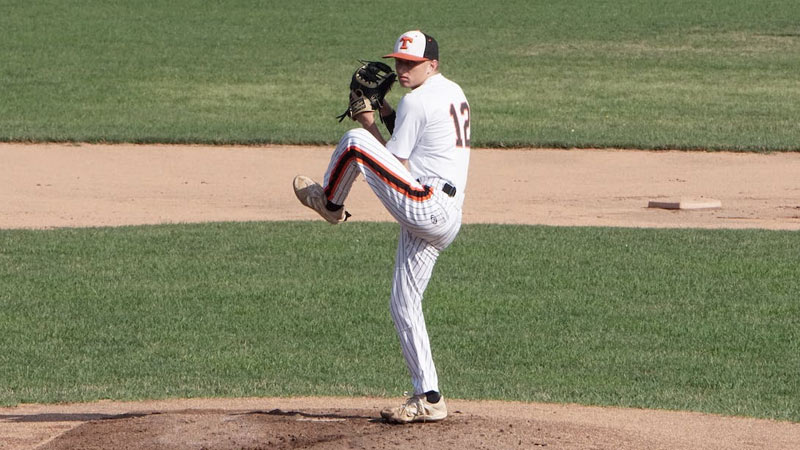Baseball is a game of precision and strategy, where pitchers play a crucial role in determining the outcome of each at-bat. To have fair play, Major League Baseball (MLB) has established a set of rules governing pitching techniques.
Here, you will find strict guidelines about what to follow and what not such as an illegal pitch.
An illegal pitch violates these rules and regulations, resulting in consequences for the pitcher and potential advantages for the opposing team. It is a throw made by a pitcher that simply goes against the MLB rules and regulations.
In the following, we will learn what makes a pitch illegal in MLB. So, by the end of this guide, you will be able to determine the balance between the pitcher and the batter and get one more step ahead with baseball.
What Is An Illegal Pitch In Baseball
We have more or less a few ideas about what makes a pitch illegal in baseball. The Major League Baseball (MLB) has defined a set of rules to maintain the harmony of baseball. An illegal pitch takes place when it doesn’t abide by the regular laws of baseball.
For example, it is illegal for the pitcher to mislead, rush, or shock the batter by emulating a pitch especially when he is not in the rubber. Furthermore, it is against the rules to “quick pitch” the batter when the pitcher steps on the rubber quickly and pitches without a sign.
The Tragic History of Pitch Law in Baseball
Ever since baseball was created, different rules were applied to keep the pitch in order. In 1898, the first balk rule was approved. Three years later in 1901, the infield fly rule was developed.
However, MLB Pitching Rules went through a dramatic change when, in 1920, Ray Chapman died from a spitball. This was when the pitcher lost control of the pitch and Chapman was hit by a spitball. Immediately new pitching rules were developed.
With new pitching rules, the use of spitballs or any elements that can increase the chances of accidents was banned.
What Makes a Pitch Illegal in MLB?
Follow the few listing below to find out what makes a pitch illegal in MLB. With you, we will also revise our baseball knowledge base and ensure a to-be baseball player is aware of the pitching rules.
The Balk
In baseball, the balk combines a set of moves – not just one. Pitchers can deliver a number of illegal moves or motions that can trigger a balk in baseball.
In the United States of America and Canada, baseball teams are governed under the official baseball rules; which state that, a balk in baseball always results in a dead ball or delayed ball.
Balks are called in 13 different ways in professional baseball, but much fewer in Little League (players between 9-12 years old) and Junior Leagues (players between 13-15 years old).
Below are some of the popular Balk Moves in baseball.
1. Flinching:
In pure words, flinching refers to a nervous move or a quick/ sudden move in response to fear or excitement. Although flinching is considered an act of players driven by instinct, it is a part of players’ natural delivery in baseball.
But when a player fails to deliver a pitch out of flinching, the umpire will mark it as an illegal pitch. Flinching is often hard to point out because it’s merely a slight movement.
The Major League Baseball (MLB) has set flinching rules under Rule 6.02(a)(1) with,
“The pitcher, while touching his plate, makes any motion naturally associated with his pitch and fails to make such delivery”
Most flinches take place while the pitcher is in the stretcher position.
Note Down A Few Things:
Stretcher Position: When a pitcher holds the pitch in his hand with his pivot foot still in contact with the pitcher’s plate and the other foot out of the pitcher’s plate while he is facing the batter.
2. Quick Pitch:
It can be the most common type of balk movement in baseball. A quick pitch occurs when the pitcher delivers the ball before the batter is ready. Often a quick flinch is mistaken for a set position (find out next).

Quick pitches are often considered harmful to the progress of the game. Because it often catches the batter off-guard and can injure them physically.
For Quick Pitch, Major League Baseball has Rule 6.02 (a)(5): “The pitcher makes an illegal pitch”; followed by: Rule 6.02 (a)(5) Comment:
“A quick pitch is an illegal pitch. Umpires will judge a quick pitch as one delivered before the batter is reasonably set in the batter’s box. With runners on base, the penalty is a balk; with no runners on base, it is a ball. The quick pitch is dangerous and should not be permitted.”
3. Out of Set Position:
In baseball, a set position refers to a player’s position from where he will deliver the pitch.
A pitcher is in the set position when his pivot feet are against the pitching rubber and his both arms face the base (first base for lefty pitchers and third base for righty pitchers). Meanwhile, he is holding the ball using both hands.
When a pitcher doesn’t come to a complete stop in the set position but in the meantime delivers the pitch, it is considered an illegal pitch.
MLB rules require pitchers to pause briefly to eliminate the element of surprise and maintain fairness. Rule 6.02 (a)(13) says indicates, “The pitcher delivers the pitch from Set Position without coming to a stop.”
This is an illegal pitch. Quick Pitch and Out of Set Position; are almost similar in pitch delivery. Thus, people often mistake them for one another.
4. Fake Pick-Off
Around the year 2013, faking a pitch to the first or third base overstepped the MLB Rule 6.02(a)(2), “The pitcher, while touching his plate, feints a throw to first or third base and fails to complete the throw.”
Before the 2013 Major League Seasons, this rule was partially applied. Back then, it was illegal to fake a pitch to the first base only. But this allowed the pitchers to fake a throw to the third base and cunningly retire the first base runner.
Later, upon discussion, it was decided that allowing the pitchers to fake it to third base was clearly not fair. Thus, the rule was improvised and third base was brought under MLB Rule 6.02 (a).
You can follow baseball rules academy to learn more about pitchers’ illegal actions. However, because the rule was implemented only a few years back (earlier 2013), senior pitchers often harvest this habit to fake a throw at the third base. Especially, several high school leagues still considered the act as a legal move.
5. Ball Drops
While most balks are considered naturally occurring events, umpires often consider them if these incidents are unintentional. But one of the most common balk types is when the ball drops off the pitcher’s hand.
MLB has set Rule 6.02 (a)(11) saying that, “The pitcher, while touching his plate, accidentally or intentionally has the ball slip or fall out of his hand or glove” will be considered a balk.
Slipping off the ball is a common mistake in MLB seasons. And there have been frequent records of this balk action.
Here are some of the common balk types in baseball. But there are more. For example, pitchers slipping during a delivery or faking a windup (the first phase of pitching motion), also fall under the balk act of illegal pitch in baseball.
Don’t confuse them with other illegal pitch types in baseball. Let’s dive into the other forms of pitchers’ illegal acts in baseball.
Foreign Objects
In the MLB seasons, pitchers can use rosin or other league-approved elements to have a better grip on the baseball. However, substances that can easily harm themselves or alter the course of the game such as spider tack, use of pine tar, or heavy sunscreen are strictly prohibited in the play.
However, no official laws were permitted regarding the use of foreign substances in the field until recently Rob Manfred, Commissioner – of MLB indicated the formation of Rules 3.01, 6.02 (c), and (d) saying,
“I understand there’s a history of foreign substances being used on the ball, but what we are seeing today is objectively far different, with much tackier substances being used more frequently than ever before. It has become clear that the use of the foreign substance has generally morphed from trying to get a better grip on the ball into something else — an unfair competitive advantage that is creating a lack of action and an uneven playing field.”
These rules strictly prohibited the use of any foreign objects. Description below:
Rule 3.01 states that “no player shall intentionally discolor or damage the ball by rubbing it with soil, rosin, paraffin, licorice, sandpaper, emery paper or other foreign substance.”.
While Rule 6.02(c) supports Rule 3.01 saying, pitchers can’t apply a “foreign object to the ball”, or “deface the ball in any manner”, “or throw a shining ball, spitball, mud ball or emery ball”, or “attach anything to his hand, any finger or either wrist (e.g., Band-Aid, tape, Super Glue, bracelet, etc.).”
Keep in mind, any substances that can change the nature of baseball or give pitchers an unfair advantage should be kept out of the field. However, a small amount of rosin is out of MLB prohibition to improve the grip of the players.
Consequences of Illegal Pitching in Baseball
Our chief umpire is the one to decide what penalty to draw based on the nature of the illegal pitching. Take a look below

1: Warning
Umpire doesn’t come with the final verdict early! If he finds out that the player’s move was unintentional, he will deliver a verbal warning first without any penalty.
2: Call A Ball
Often you may notice the opposing team is rewarded a ball. This happens mostly in the case of a quick pitch. Special scenarios can influence the decision of the umpire such as:
- The pitcher throws the ball with no runner on the base, it will be an automatic ball.
- In case the same thing happens on the fourth ball, the batter will get the first base.
3: Runners Get the Upper Hand
For any illegal acts like the use of foreign objects or intentional flinching in such a way as to influence the match while the runner is still on the base, the umpire-in-chief will allow the runner to reach the new base. It will be a penalty for the pitcher to act on an illegal pitch.
4: Ejection and Suspension
On the baseball field, the umpire is ultimately in charge of the final decision. In case he finds out players have intentionally performed an illegal pitch even though they had a warning before, he can decide to eject or suspend the player on an instance.
Moreover, the MLB commissioner holds all the right to take additional actions against any player based on any illegal action taken by them.
Wrapping Up on Illegal Pitch in Baseball
For any illegal pitch, the chief umpire announces a dead ball. He derives a clear line between an illegal pitch and an illegal move to conclude.
However, illegal practices which offer the pitchers unfair advantages are highly discouraged in the MLB. And so, rules were created to complete fair play till the end. In the end, nobody wants another Gaylord Perry on the team who was notorious for using foreign objects on the baseball.
Thus, a proper follow-up to the MLB rules is more than mandatory. It shapes the dynamic between both parties and lets spectators have a fair game.
In this article, we have covered important aspects of illegal pitching and actions against it. Next time when someone asks you what is an illegal pitch in baseball, don’t hesitate to share this article with them.







